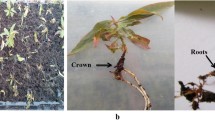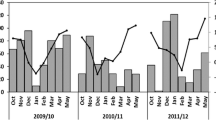Abstract
Cultivated Platysace lanceolata cv. Valentine Lace plants in south-east Queensland are affected by root rot that reduces shoot growth and flower production, and leads to plant death. Pythium irregulare, Rhizoctonia solani and Cylindrocarpon lichenicola were isolated from diseased roots using selective media and their pathogenicities tested under glasshouse conditions. Parameters used to assess disease severity included the proportion of the root system visibly rotting, the weight and size of the root system, and the proportional increase in total shoot length. Glasshouse plants inoculated and colonised with R. solani and C. lichenicola did not develop the symptoms of the field disease. Inoculation and colonisation with P. irregulare caused a detectable increase in root rot only when roots were wounded at the time of inoculation. However, root size, root weight and shoot length increases of plants inoculated with P. irregulare were all lower than those of non-inoculated plants, either with or without wounding. The combination of wounding and inoculation with P. irregulare resulted in rotting of ∼11% of the root length.
Similar content being viewed by others
References
Agresti A (1996) ‘An introduction to categorical data analysis.’ (John Wiley and Sons Inc.: New York)
Agrios GN (1997) Pythium life cycle diagram ++. In ‘Plant pathology’. p. 412. (Academic Press: San Diego, CA)
Bullock S, Summerell BA, Von Richter L (1998) First record of vascular wilt of flannel flower caused by Fusarium oxysporum. Australasian Plant Pathology 27, 49–50. doi: 10.1071/AP98005
CAB International (2004) Crop protection compendium. Available at http://www.cabi.org/compendia/cpc/index.htm [Verified 23 February 2009]
Canadian Biodiversity Information Facility (2003) Integrated Taxonomic Information System Database. Available at http://www.cbif.gc.ca/ home_e.php [Verified 23 February 2009]
Conway J (2008) Isolation and pathogenicity testing of fungi and oomycetes from root rot lesions of Platysace lanceolata. MA (Philosophy) Thesis, University of Queensland, Brisbane.
Davet P (2004) ‘Microbial ecology of the soil and plant growth.’ (Science Publishers: Enfield)
Fowler J, Cohen L, Jarvis P (1998) ‘Practical statistics for field biology.’ (John Wiley and Sons Ltd: Chichester)
Garret SD (1978) The soil-root interface in relation to disease. In ‘The soilroot interface’. (Eds JL Harley, RS Russell) (Academic Press: London)
Holliday P (1989) ‘A dictionary of plant pathology.’ (Cambridge University Press: Cambridge)
Hutton DG, Forsberg LI (1991) Phytophthora root rot in hydroponically grown lettuce. Australasian Plant Pathology 20, 76–79. doi: 10.1071/ APP9910076
Isaac S (1992) ‘Fungal-plant interactions.’ (Chapman and Hall: Melbourne)
Knoxfield Herbarium (2006) ‘National collection of fungi index.’ (Victorian Department of Primary Industries: Melbourne)
Punja ZK, Chittaranjan S, Gaye MM (1992) Development of black root rot caused by Chalara elegans on fresh market carrots. Canadian Journal of Plant Pathology 14, 299–309.
Singleton LL, Mihail JD, Rush CM (Eds) (1992) ‘Methods for research on soilborne phytopathogenic fungi.’ (The American Phytopathological Society: St Paul, MN)
Stanley TD, Ross IM (1986) ‘Flora of south-eastern Queensland. Vol. 2.’ (Queensland Department of Primary Industries: Brisbane)
Tsao PH (1990) Why many Phytophthora root rots and crown rots of tree and horticultural crops remain undetected. EPPO Bulletin 20, 11–17. doi: 10.1111/j.1365-2338.1990.tb01174.x
Tsao PH, Ocana G (1969) Selective isolation of species of Phytophthora from natural soils on an improved anitbiotic medium. Nature 223, 636–638. doi: 10.1038/223636a0
Van der Platts-Niterink AJ (1981) Monograph of the Genus Pythium. Studies in Mycology 21, 1–242.
Watanabe T (2002) ‘Pictorial atlas of soil and seed fungi.’ (CRC Press: Boca Raton, FL)
Author information
Authors and Affiliations
Corresponding author
Rights and permissions
About this article
Cite this article
Conway, J.R., Joyce, D.C., Galea, V.J. et al. Pythium irregulare can cause root rot of Platysace lanceolata . Australasian Plant Pathology 38, 411–416 (2009). https://doi.org/10.1071/AP09017
Received:
Accepted:
Issue Date:
DOI: https://doi.org/10.1071/AP09017




